To cope with digital burnout and overload, start by recognizing signs like tired eyes or poor focus. Set clear boundaries by scheduling tech-free zones and times, and use tools to monitor your usage. Practice mindfulness and take regular breaks to recharge, limiting notifications and multitasking. Incorporate offline activities like walks or hobbies to balance your routine. If you want practical tips to regain control, plenty more strategies are available to explore.
Key Takeaways
- Set clear boundaries by scheduling regular digital detoxes and device-free zones to reduce overwhelm.
- Prioritize tasks and organize using to-do lists to manage information overload effectively.
- Limit notifications and alerts, customizing settings to focus on essential updates only.
- Practice mindfulness and offline activities like hobbies or outdoor walks to reconnect and reduce digital fatigue.
- Seek support from mental health professionals or online communities to address stress and build resilience.
Recognizing the Signs of Digital Overload
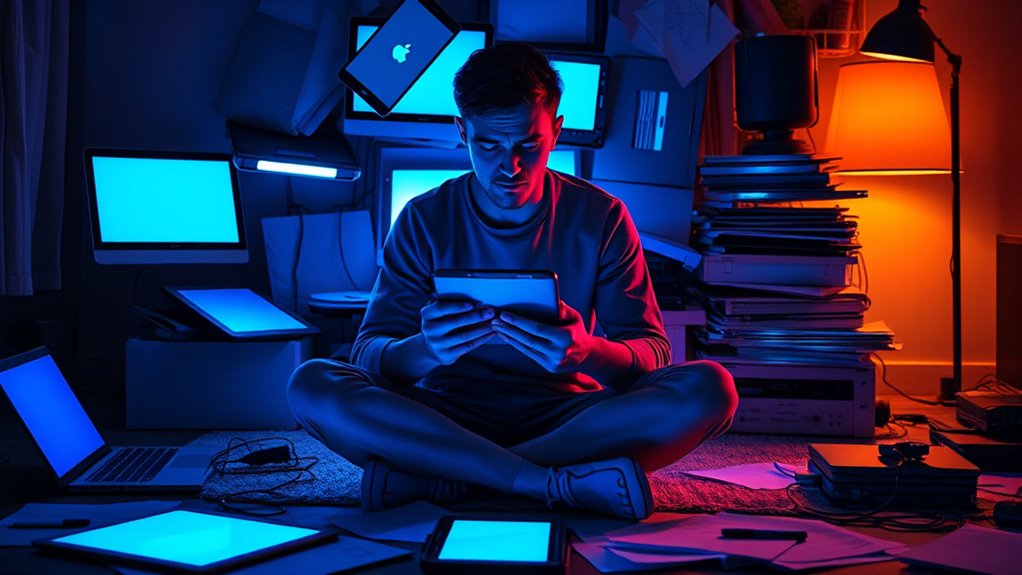
Digital overload often sneaks up on you, making it hard to notice until you’re overwhelmed. You might feel constant digital fatigue, with tired eyes and a sluggish mind. Information overload can leave you confused, struggling to process or remember details from multiple screens and notifications. You may find yourself scrolling endlessly, feeling anxious or irritable without understanding why. Your focus diminishes, and tasks take longer to complete. You might experience headaches, trouble sleeping, or a sense of disconnect from real life. Recognizing these signs early helps you understand you’re experiencing digital overload. Paying attention to your body and mood is key. If you notice these symptoms, it’s a clear signal to pause and reassess your digital habits before burnout worsens. Being mindful of your screen time can also help prevent digital fatigue from escalating.
Setting Boundaries With Technology
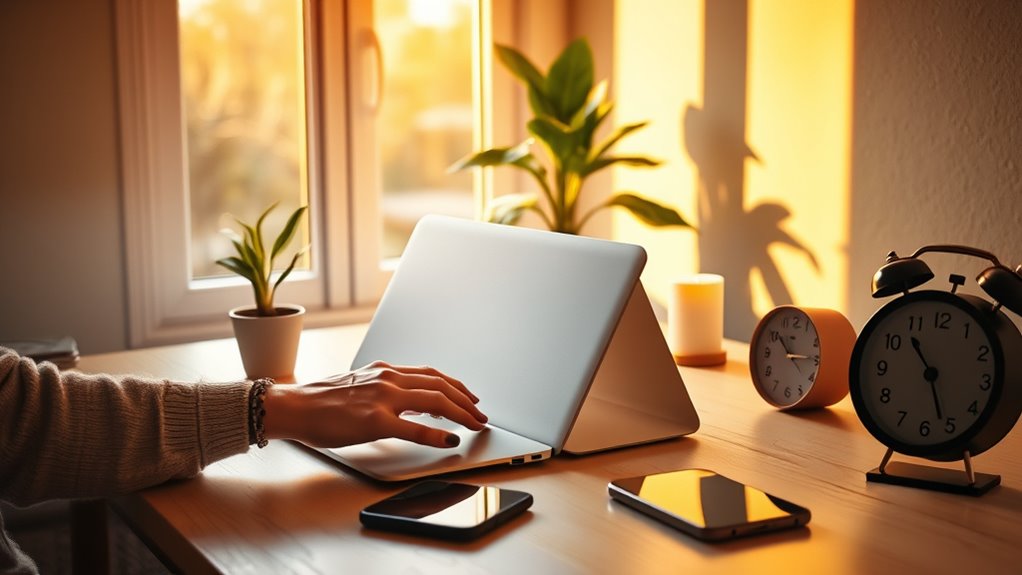
You can start by creating tech-free zones in your home where devices aren’t allowed, helping you disconnect and recharge. Setting clear screen time limits guarantees you don’t spend too much time online or on your devices. These boundaries give you control and help prevent digital overload from taking over your day. Additionally, being mindful of screen time management can further support your efforts to maintain a healthy balance with technology.
Establish Tech-Free Zones
Creating designated tech-free zones within your home or workspace is an effective way to set clear boundaries with technology. These zones help reinforce your digital boundaries by providing physical spaces where devices are off-limits. For example, designate your bedroom or dining area as a no-device zone to encourage real-world connections and rest. By establishing these boundaries, you reduce the urge to check screens constantly, making it easier to disconnect and focus on the present moment. Tech-free zones create a physical reminder to prioritize your well-being, helping you regain control over your digital habits. Consistently maintaining these zones fosters healthier relationships with technology, allowing you to recharge and enjoy downtime without digital distractions. Incorporating screen time management strategies into your routine can further support your efforts to reduce digital overload.
Define Screen Time Limits
Setting clear screen time limits is essential for maintaining a healthy balance between technology use and personal well-being. By setting time limits, you prevent digital overload and protect your mental health. Use monitoring app usage features to track how long you spend on various devices and apps. This awareness helps you identify patterns and adjust your habits accordingly. Establish specific boundaries, such as limiting social media to 30 minutes daily or turning off screens an hour before bed. Consistently monitoring your usage keeps you accountable and reinforces healthy boundaries. Remember, the goal isn’t to eliminate technology but to use it intentionally and mindfully. Defining and enforcing these limits empowers you to enjoy the benefits of digital tools without becoming overwhelmed. Incorporating essential oils for stress relief into your routine can also support relaxation and mental clarity during tech breaks.
Creating Tech-Free Zones and Times

You can reduce digital overload by setting specific times when you disconnect completely. Creating device-free spaces in your home or office encourages more meaningful connections and focus. Scheduling regular digital breaks helps you recharge and prevents burnout throughout the day. Incorporating tech-free zones into your routine can significantly improve your overall well-being and mental clarity.
Designate No-Tech Hours
To combat digital overload, establishing designated no-tech hours can make a significant difference. By setting aside tech-free mornings or unplugging weekends, you create space to reconnect without distractions. These periods allow your mind to rest and recharge. Schedule specific times when devices stay off, like during meals or an hour before bed. Use the table below to plan your no-tech hours:
| No-Tech Activity | Suggested Timing |
|---|---|
| Unplugging weekends | Entire weekends |
| Tech-free mornings | 7:00 am – 9:00 am |
| Evening wind-down | 8:00 pm – 9:00 pm |
| Family meals | During breakfast/lunch/dinner |
Consistently practicing these hours helps reduce overwhelm and fosters meaningful connections away from screens. Incorporating digital detox periods into your routine can further enhance your well-being and mental clarity.
Establish Device-Free Spaces
Creating device-free spaces involves intentionally designating certain areas or times in your home where screens are off-limits. These device free zones help you disconnect and foster real-world connections. Choose spaces like the dining room, bedroom, or living area as your designated tech free spaces, ensuring they’re free from phones, tablets, and laptops. Establish specific times, such as during meals or before bed, when devices stay out of reach. Setting clear boundaries creates a physical reminder to prioritize face-to-face interactions and mental rest. By creating these zones, you reduce digital overload and build healthier habits. Consistency is key; over time, you’ll find it easier to enjoy quality moments without the distraction of screens. Integrating AI security tools can also help monitor and manage your digital habits, further supporting healthier boundaries. These intentional spaces serve as a crucial step toward managing digital burnout.
Schedule Regular Digital Breaks
Scheduling regular digital breaks is essential for maintaining a healthy balance between screen time and real-life interactions. These mindful breaks help prevent burnout and foster mental clarity. By creating tech-free zones and designated times, you give yourself space to recharge. Consider implementing a digital detox period daily, such as during meals or an hour before bed. To organize your schedule effectively, try this:
| Time Slot | Activity | Zone |
|---|---|---|
| Morning | Meditation or stretching | Bedroom |
| Midday | Walk outside | Garden or Park |
| Evening | Reading or hobbies | Living room |
| Breaks | Short mindful pauses | Anywhere |
| Sleep Time | No screens | Bedroom |
These intentional pauses promote well-being and reduce overload, helping you stay balanced. Incorporating unique high-quality products into your space can also enhance relaxation and create a calming environment during your breaks.
Practicing Mindfulness and Digital Detoxes
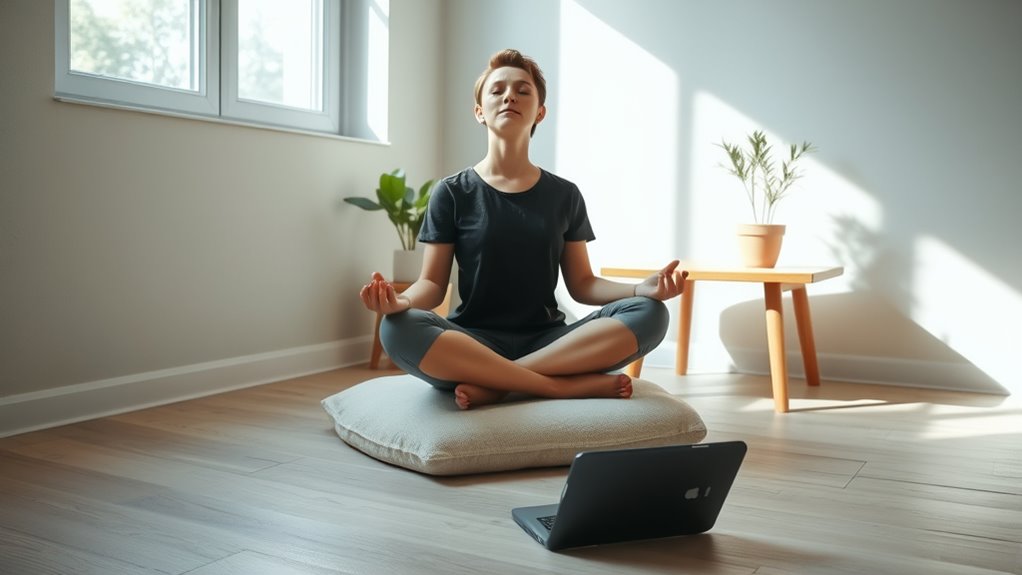
Practicing mindfulness and taking regular digital detoxes can markedly reduce feelings of burnout and overload. By engaging in digital mindfulness, you become more aware of how your devices affect your mental state. Mindful technology use encourages intentional interactions rather than mindless scrolling, helping you stay present. Digital detoxes provide necessary breaks from screens, allowing your mind to reset and recharge. Incorporate activities like meditation, deep breathing, or simple reflection to cultivate awareness of your digital habits. Setting aside specific times to disconnect fosters a healthier relationship with technology. These practices help you regain control, reduce stress, and restore focus. Regularly practicing mindfulness and detoxing from digital devices can markedly improve your overall well-being and help you cope better with digital overload. Additionally, exploring fan communities and creative outlets can provide fulfilling alternatives to screen time, enriching your digital experience in a balanced way.
Managing Notifications and Alerts Effectively
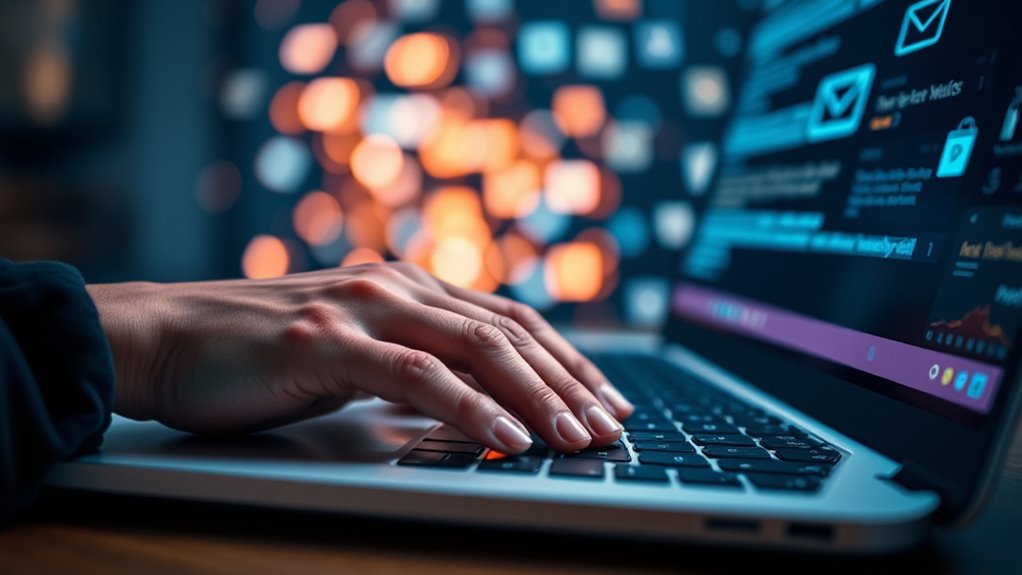
Managing notifications and alerts effectively is a key step in maintaining your digital well-being. Start by practicing notification management: turn off non-essential alerts that distract you or cause stress. Use alert customization features to prioritize important messages, so only critical notifications interrupt your focus. Adjust settings on your devices to limit alerts during work or personal time, reducing constant interruptions. Consider setting specific times to check notifications instead of responding immediately. By tailoring alert frequencies and types, you regain control over your digital environment. This approach minimizes overload and helps you stay focused on what matters, preventing digital burnout. Remember, proactive notification management empowers you to create a healthier digital routine and maintain your mental clarity. Incorporating Glycolic Acid benefits into your skincare regimen can also serve as a reminder to prioritize self-care and balance in your daily routine.
Prioritizing Tasks and Limiting Multitasking
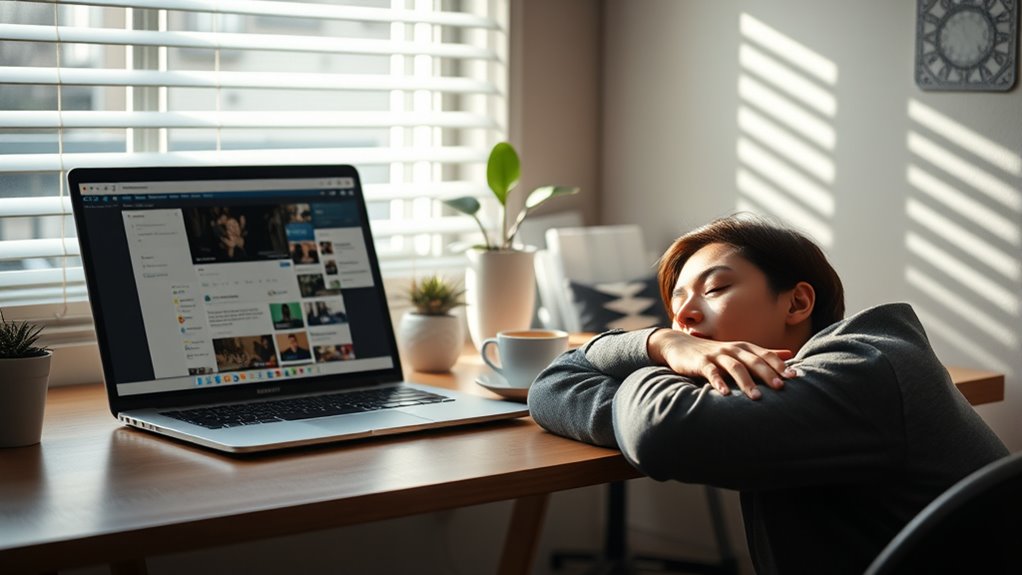
Focusing on one task at a time enhances your productivity and reduces mental clutter. To achieve this, practice task prioritization by sorting tasks based on importance and deadlines. Use tools like to-do lists or digital planners to stay organized. Limiting multitasking helps prevent scattered attention and mistakes. When you try to do multiple things simultaneously, your brain struggles to switch focus, leading to fatigue and decreased efficiency. Instead, set clear boundaries—dedicate specific blocks of time to each task. Resist the urge to jump between activities and instead complete one before moving on. This approach streamlines your workflow, reduces stress, and minimizes digital overload, making it easier to stay focused and accomplish your goals without feeling overwhelmed.
Incorporating Offline Activities Into Your Routine

Have you considered how offline activities can refresh your mind and reduce digital fatigue? Engaging in hobbies and interests away from screens helps you reconnect with yourself and minimizes overload. Outdoor activities like walking, biking, or gardening boost your mood and provide a healthy break from digital devices. Incorporate these activities into your routine by scheduling regular time blocks dedicated to them. For example, set aside weekends for a hike or evenings for reading a physical book. These simple changes can improve your mental clarity, reduce stress, and restore your energy. By intentionally making room for offline pursuits, you create a balanced lifestyle that counters digital burnout and keeps you more present in the moment.
Seeking Support and Professional Help
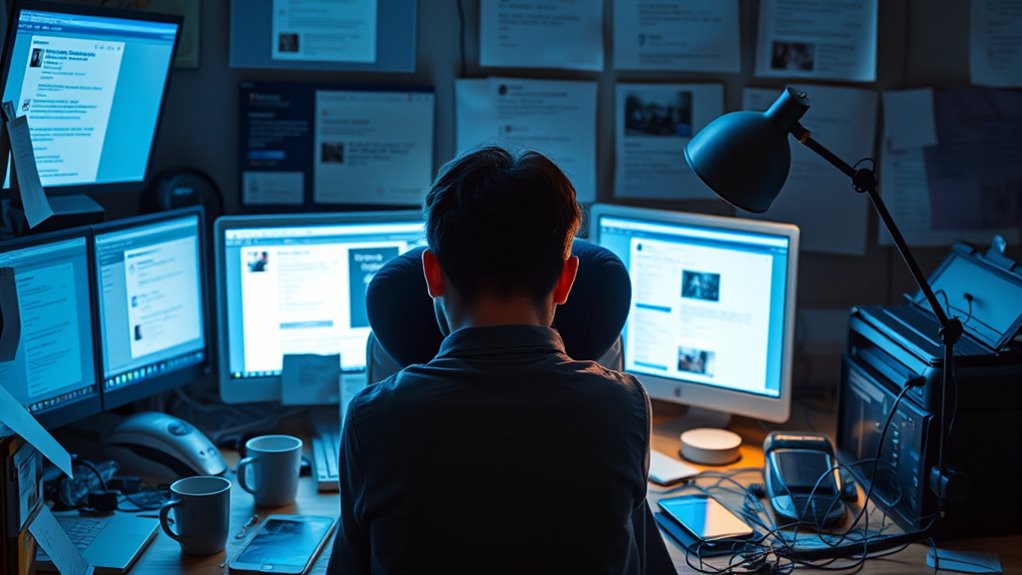
When offline activities aren’t enough to ease digital burnout, reaching out for support can make a significant difference. Connecting with mental health support or counseling resources provides a safe space to discuss your feelings and develop coping strategies. Whether through therapy, support groups, or online counseling, professional help can address underlying stressors and prevent burnout from worsening.
| Support Type | Benefits | How to Access |
|---|---|---|
| Mental health support | Offers emotional guidance | Contact local therapists |
| Counseling resources | Provides tailored strategies | Search online directories |
| Support groups | Shares experiences, reduces isolation | Join community or online groups |
| Online therapy | Convenient, accessible support | Sign up through platforms |
| Crisis helplines | Immediate assistance | Call helpline numbers |
Frequently Asked Questions
How Can I Tell if Digital Burnout Is Affecting My Mental Health?
You might notice signs of fatigue, like feeling constantly tired or having trouble concentrating, which can indicate digital burnout affecting your mental health. Mood changes, such as increased irritability or sadness, are common signs too. If you find yourself overwhelmed after screen time or losing interest in activities you usually enjoy, it’s a good idea to evaluate your digital habits and consider taking breaks to improve your well-being.
What Are Practical Ways to Disconnect Without Work Repercussions?
To disconnect without work repercussions, consider scheduling a regular digital detox, setting specific times when you turn off devices. Engage in offline activities like reading, outdoor walks, or hobbies that help you recharge. Communicate your boundaries clearly with colleagues and managers, and use tools like auto-reply messages. Prioritizing these habits guarantees you stay connected to your mental health while maintaining professionalism and avoiding work-related issues.
How Do I Balance Screen Time With Family and Social Activities?
Think of your screen time as a garden—you need to tend it carefully. To balance it with family boundaries and social engagement, set specific tech-free zones and times, like dinner or weekends. Prioritize quality interactions over passive scrolling, and be intentional about unplugging. Just as a garden flourishes with careful attention, your relationships thrive when you actively nurture them beyond screens.
Are There Tools to Monitor and Limit My Digital Usage Automatically?
You can use tools designed for Digital Wellbeing and Usage Tracking to automatically monitor and limit your digital usage. Apps like Screen Time on iOS, Digital Wellbeing on Android, and third-party options like Freedom or StayFocusd help you set limits, block distracting sites, and track your habits. These tools give you better control over your screen time, encouraging healthier digital habits and helping you stay balanced in your daily routines.
How Can Employers Support Employees Experiencing Digital Overload?
Employers can support your employee wellness by encouraging regular digital detox breaks and setting clear boundaries for work hours. They can implement policies that promote unplugging after hours and provide resources like mental health support or flexible schedules. Offering workshops on managing digital overload helps you develop healthy habits. These efforts create a balanced work environment, reduce burnout, and help you recharge, ultimately boosting productivity and overall well-being.
Conclusion
Think of digital life as a sprawling garden. Without careful tending—setting boundaries, pruning distractions, and nurturing offline moments—your garden can become overwhelming and wild. By actively managing your tech use, you’re cultivating a space where balance blooms. Remember, you hold the gardener’s tool; with intention and care, you can prune burnout, water mindfulness, and allow your well-being to flourish amidst the digital landscape.









